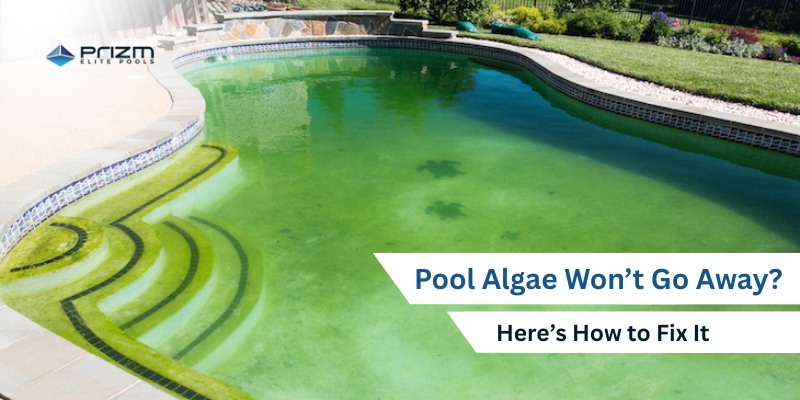Why Pool Algae Keeps Coming Back—and How to Stop It
Algae in your pool can be annoying. Whenever you think you have it under control, it just seems to return. This issue is common for pool owners. To avoid cloudy water, you should understand why algae keep reappearing. We will look at the leading causes of algae growth and provide tips to stop it from returning.
What Is Pool Algae?
Algae in the pool are living plants that can develop in your water. It may dye your pool water and give it a cloudy or unclean appearance. Algae may be found floating or attached to the walls and surfaces of your pool.
There are several kinds of pool algae.
- Green Algae: It may appear as a green film floating on the water or stuck to the walls of a pool. It increases when the water is not clear or properly filtered.
- Black Algae is hard to remove because it grows strong roots on surfaces like plaster or concrete. It appears as dark spots with a greenish appearance.
- Brown Algae: Usually spotted in cold waters, they are yellowish-brown. They can hang it on the wall of your pool or make it float.
- Pink Algae: Pink slime is also called pink slime because it appears as a pink or reddish film in places with little light or air movement.
- Yellow Algae: Also known as mustard algae, this organism grows in yellow or brown patches and can be challenging to remove in shaded areas.
Algae can make the water in your pool look cloudy and unsafe for use. A lack of proper sanitation may also be the cause, helping harmful bacteria to grow. Fast algae growth happens when there are chemical problems, the water does not move well, or the pool is not cleaned regularly.
Common Reasons Why Pool Algae Keeps Coming Back
1. Imbalanced Water Chemistry
Keeping the pH, chlorine, and alkalinity levels in your pool balanced is essential. Chlorine kills algae and germs, but it must be used when the water’s pH and alkalinity are correct. If the water is too acidic or basic, chlorine will not be effective, and algae can quickly begin to grow.
2. Poor Water Circulation
3. Inadequate Filtration and Cleaning
Your pool filter removes dirt and small algae spores from the water. If the filter is blocked or has dirt, it will not clean the water well. For this reason, algae can regrow. If you do not regularly clean your tank and filter, algae will continue to appear.
4. Organic Debris and Nutrient Build-up
Algae can eat any leaves, dirt, or debris in the pool. If you do not clear away this debris promptly, algae will use it to grow more quickly. If you remove the leaves and dirt, you prevent algae from growing and spreading.
5. Skipping or Irregular Shock Treatments
“Shocking” your pool involves putting in a significant amount of chlorine to kill any algae or bacteria that regular chlorine might not reach. If you do not use shock treatments or only use them occasionally, algae may survive and return. After heavy rain or pool parties, regular shock treatments will keep algae at bay and keep the water looking clear.
How to Stop Algae from Coming Back—Effective Solutions
1. Maintain Balanced Water Chemistry
If your water is not balanced, add the needed chemicals a little at a time. Be sure to read and obey the instructions on the chemical labels to avoid using too much. Maintaining the right water balance stops algae growth and ensures swimmers' safety.
2. Ensure Proper Water Circulation
Keep your pool pump operating for several hours each day. When water moves correctly, it does not allow algae to grow. If there are algae, keep the pump running for a full day until it clears up.
Regularly check the filter system in your home and periodically clean it so it does not provide a home for algae. If your filtration system works, your pool water will stay fresh and clear.
3. Clean Your Pool Regularly
Always use a skimmer net to remove leaves, bugs, and dirt from the water each day. Brush the pool walls and floor daily to prevent algae from forming and sticking.
If the pool needs it, vacuum it to pick up fallen debris. Wash your filter baskets weekly and backwash your filter at least once a month.
4. Use Algaecide Preventatively
Algaecide is available as a liquid or powder. To prevent algae from appearing, add algaecide to the water once every seven days.
Use the product as directed by the instructions. Applying algaecide often prevents algae from growing and keeps your pool water clean.
5. Regular Shock Treatments
To kill algae and bacteria, raise the chlorine in your pool. You should do this at least once a week after it rains heavily or after a pool party.
Shocking your pool at night is recommended since sunlight does not evaporate chlorine as quickly. Read the instructions to ensure your pool is clean and safe to use.
Conclusion
It is not always easy to stop algae, but maintaining a tidy and well-balanced pool makes a big difference. Check your water regularly, keep your pump running, and keep the pool clean. Try algaecide and shock treatments to stop algae from reappearing. To keep your pool sparkling, contact Prizm Elite Pools and get expert help today.






Comments
Post a Comment